Narrelle M. Harris's Blog, page 18
October 4, 2019
The Lady Novelist is Charmed by a Hobbit Village

I am once more on the road, spending 11 days in New Zealand with my travel-writing husband, Tim Richards. Starting in Auckland, we’re taking trains (and a ferry) in stages southward and will end up in Christchurch.
Our first day in Auckland was spent initially with Dane of the Home Fires of Tamaki, learning about Maori history through arrival, colonisation, contemporary issues and the future – a superb, engaging and dynamic experience, and Dane’s an excellent and passionate storyteller. That afternoon was a wine tour on Waiheke Island which Tim’s written about.
The next day, however, we zipped down to Hamilton on the train and met Amber, who drove us to Hobbiton!
 Samwise and Rosie’s house
Samwise and Rosie’s house
I knew of Hobbiton of course. I remember that in the early days, just after Lord of the Rings, people had started to seek out the New Zealand farm that had been transformed into the hobbit village in the Shire where Bilbo Baggins, Frodo, Samwise, Merry and Pippin all lived.
 underhill window
underhill windowThe place had been meticulously built with lots of detail, but after the filming was over most of it was taken away again. People came to see it anyway. Then The Hobbit (expanded into a trilogy) was made, so Hobbiton was recreated all over again, only this time the Armstrong family (owners of the sheep and cattle farm on which the village was built) managed to negotiate to keep everything in situ.
Now, hundreds of thousands of people visit a year, and you can’t go through it without a guide (possibly to make sure LOTR fans don’t go breaking off bits of hobbit houses to take home, or keen gardeners don’t denude the gardens and landscapes of cuttings).
 A florist lives here
A florist lives hereI thought I might find the hobbit village cute and fun to visit because of its Tolkein connections: I didn’t realise just how delightful the whole thing would be! Because it’s not just a leftover set from a set of two trilogies.
 Giant bumblebee on the left…
Giant bumblebee on the left…Hobbiton in fact works on several levels: one of which is that it’s a living landscape, with glorious flowerbeds and lush vegetable patches; it has apple trees and herbs like mint and rosemary growing tall; as you walk around the village and up the hill to Bag End, a dell full of bluebells is below one track. A fat, loud, frankly enormous bumblebee (of the size I’ve seen in the UK but never in Australia) looms around bright red flowers.
The scent of all this nature combines with the fragrant smoke of four or five chimney stacks, which are stoked up with manuka woodchip to add the final touch to a delicious aroma that infuses Hobbiton.

On another level, Hobbiton is like a sculpture garden, with its curated plant life dotted all round with an art installation: “The Homes of Hobbits and How They Live”.
 The fake oak tree over Bag End
The fake oak tree over Bag EndAt the same time as you’re enjoying the charming garden, and marvelling at the artistry of the hobbit houses and all the fine detail that is put into making the village feel occupied and as though the hobbits are all just at a party at another village, you have the nostalgia of remembering the films, and then the insider-delight of seeing under the skin of the movie magic.
For lovers of the Tolkein books and films, there’s the delight of seeing the Party Tree under which Bilbo holds his eleventy-first birthday party. That’s a real tree, unlike the oak which stands atop Bag End, which is entirely artificial and has 200,000 leaves wired onto it.
 Southfarthing brews
Southfarthing brewsAfter cooing over Hobbiton – our guide, River, even has a Middle Earthish name – we walk down the path to the Green Dragon Inn, where a hungry hobbit or human can fill up on a well made lunch or try out the ale, stout, cider or ginger beer (all brewed locally by Hamilton brewer Good George). The first three are brewed exclusively for the Inn, and I discovered for the first time that stout is… chocolatey! The ginger beer is still my favourite though.
 A green dragon over the inn door
A green dragon over the inn doorIf you’re wondering if it’s worth a trip to Hobbiton, is absolutely is. Even if you’re not a fan of the Peter Jackson films or even Tolkein at all.
Find out more about Hobbiton Movie Set Tours
 Party tree to the left, the Green Dragon over the lake.
Party tree to the left, the Green Dragon over the lake. Bag End
Bag End
October 3, 2019
Research: Richard III

In case you didn’t know, I’m something of a Ricardian as a result of always having been intrigued by Shakespeare’s play, which is brilliant but hardly believable as documentary evidence of anything except Tudor revisionism. My further reading led me to the conclusion that history’s Richard was hard done by.
Whatever his real faults and crimes, I joyfully took up the unequivocal pro-Richard cause as a balance to all the Tricky Dicky hate that’s out there.

I’ve written a couple of pro-Richard stories, which were published in Grant Me the Carving of My Name and have low key aims to write an alternative history one day. I have no particular plot yet, but I’ve been doing general reading and research to deepen my knowledge of complexities surrounding the War of the Roses and Richard’s short reign.
While in London recently, I did my favourite London activity, which is to read old books at the British Library.
Horace Walpole and I
 Richard
RichardThe first I looked at was a 1770 edition of Horace Walpole’s Historic Doubts on the Life and Reign of King Richard the Third, where he explores all the charges levelled against Richard Plantagenet by Shakespeare, Sir Thomas More and a host of other Tudor historians. He uses contemporary accounts and good old courtroom logic to unpack what appears to be a heap of fabrications, misreadings, malign interpretations and Tudor self-interest.

Let’s put aside the thrill of reading a book published 285 years after Richard’s death, and 195 years before my birth and marvel at Walpole noting that the only “deformity” of Richard’s noted in his lifetime was his uneven shoulders – no sign of the limp, hunch, withered arm etc attributed to him by later historians. Richard’s scoliosis was only discovered/confirmed when they found his body in 2012.
Thank you, Mr Walpole, for researching so many primary documents so that, when i finally get to writing whatever I write, I won’t have to.
Real Person Hatefic
On the opposite side to me and Walpole, though, I found the most appalling/hilarious 18th century Richard III Real Person Fanfic by an anonymous author.
Called A Dialogue Between King Richard III and his Adopted Son and published in Dublin in 1753 (good lord, I handled a 266 year old book!), it’s set in Hell, where the spirit of King Richard III greets a recent arrival, dubbed Richard IV, who tells of his journey to the underworld.
Richard IV: I fell in much love with a great sum of money that was possess’d by a young Lady, whom I heartily despised, but as one could not be had without the other, and money was very necessary to me, I condescended to marry her.
King Richard: But cou’dn’t you get the money without committing Matrimony?
Richard IV : You may swear I cou’dn’t. I tryed indeed, but the squeamish Bitch would do nothing but in a lawful way, as she call’d it.
King Richard: Then I pardon you.
Richard IV: Yes, and I hope you will do the same for two or three more Marriages.
King Richard: With all my heart, but proceed.
Young Richard IV proceeds all right, demonstrating that he’s a wastrel, bigamist, cheat, highwayman, debaucher and general nasty piece of work, to the general applause of the dead King. Well, except for when Richard Jr plotted the death of his nephew:
Richard IV: I was long in debate with myself as whether I should murder him myself or get him murdered.
King Richard: This is the only weak part of your History hitherto. How can you say you had my Character always in view? I am almost asham’d of you, you were foolishly faint-hearted.
Of course, the knave only exiled the nephew, which act of ‘faint-hearted foolishness’ comes back to bite him on the bum when the nephew returns to England.
Richard IV: It was then I cursed myself a thousand times every Hour for being so foolishly tender as not to have dispatched him at once, for Dead Men Tell No tales.
At this point in his narrative, he claims he’ll give it all up, beg for mercy and live like a gentleman. King Richard III is not amused, saying:
King Richard: I in the like case chose to die bravely in Bosworth field, sword in hand rather than quit the least of my usurpations. I fear you were a coward.
Richard IV: I own sir I had always a great tenderness for my own person and had rather at any time have taken twenty kicks on the A___ or Twicks by the Nose than run the Risk of one Poke thro’ the Guts.’
The whole thing is blackly funny where it isn’t predictably banal, and ends with King Richard adopting this arsehole as a son before they both wind up wailing piteously with their guilt over how they treated their nephews.
Even if you think Richard did half the evil things he’s accused of (and Horace Walpole and I definitely don’t) it’s a hell of a comedown for such a grand villain to be cheering on a common thief and swindler. Even Shakespeare’s Richard has more pride.
FutureLearning Medieval England

While I was in the UK a friend put me onto Future Learn, which offers some of its courses for free.
I’ve been studying England in the Time of King Richard III and learning all sorts of things about the key players in the Wars of the Roses, layers of society, the impact of the Black Death, the development of writing, and Richard’s library.
Paying my respects to Dickon

Whatever the Tudors made of the man, Richard was popular up North with his people, and since his body was discovered and he was reinterred in Leicester Cathedral in 2015. His reinterment coincided with an unexpected victory for the Leicester City football club, so the locals have become Ricardians too.
The Leicester Museum is currently showing a royal portrait of Richard, adding another Ricardian tourism spot in addition to the Richard III Centre, the Leicester Cathedral opposite where he’s now buried, and the Bosworth Battlefield just out of town.
I like to pop by one or more of those places when I’m in town, just to say hi to the only royal I give the slightest damn about.
Who knows where all this reading will one day lead – right now my aim is to fill my brain with relevant material and let it all ferment away.

September 26, 2019
Cover Reveal: Duo Ex Machina – Kiss and Cry

I’m delighted to reveal the cover for my upcoming fourth Duo Ex Machina novella, Kiss and Cry.
Set in 2014, Kiss and Cry sees musicians and life partners Frank Capriano and Milo Bertolone facing new challenges. Milo is taking part in a celebrity ice dancing show for charity; Frank is a busy music producer. They’re both working too hard and losing touch with the love that has kept them strong for so long. At the same time, some odd things are going on with other participants in Icing It! What new and unlooked-for danger threatens them now, and is it worse than the miserable estrangement they’re going through?
Kiss and Cry is currently being serialised for my $3 supporters on Patreon. That will finish in February 2020, when all Patrons will get the book as one of their regular awards. Soon after, it will be available for general sale.
In the meantime, this is the lovely cover by Willsin Rowe, who has created all the new series covers to date.
September 19, 2019
Review: Keep Calm and Kill the Chef by Livia Day
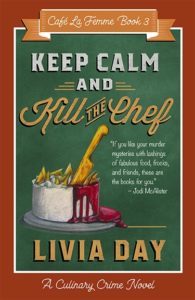 Cover art: Keep Calm and Kill the Chef
Cover art: Keep Calm and Kill the ChefI have previously blogged my absolute delight with the Cafe La Femme series by Livia Day (the name Tansy Rayner Roberts uses when she’s moonlighting as a writer of crime!)
The previous two novels and novella in this series came out a little while back, and I’ve been waiting not-entirely-patiently for this third novel to appear via Twelfth Planet Press’s Deadlines imprint. Whatever the delay, it’s been worth the wait.
Blurb for Keep Calm and Kill the Chef
Scones, tea, and a stabbing…
When Tabitha Darling entered Cafe La Femme in a reality TV show hosted by an infamous “bad boy” Chef, she never expected to be a suspect in his murder.
When Xanthippe Carides quit working in a cafe to become a private detective, she never expected one of her first cases would be keeping Tabitha out of jail…
These two friends have a mystery to solve, and only one of them is telling the whole truth.
The first treat in store is that the whole series been re-released with stunning covers by Cathy Larsen. Look at these pretty things! (And look for the details and some wonderful murdery symbols!)

The story is exactly the kind of delicious, crime-riddled confection of mystery, frocks, mouth-watering recipes, badassery and glitter I’ve come to expect from any story featuring Hobart chef, Tabitha Darling.
Keep Calm and Kill the Chef is structured like one of Tabitha’s more complex recipes. The viewpoint shifts between Tabitha and her best friend, newly minted private eye Xanthippe Carides, while it also flips timelines before and after the murder: and all of this with perfect ease and lightness of touch.
Like all the Cafe La Femme stories, Keep Calm and Kill the Chef is a little hyper-real, set in a heightened Hobart and full of characters who are collectively more vivid than you’d expect to find in one group of friends. From catsuit-wearing Xanthippe to frock-and-glittery Ceege, from bizarrely hip hipsters to unexpectedly knife-throwing-skilled kitchenfolk, everyone is bright and shiny. Even the villains.
And of course there’s Tabitha, who is a little manic, a lot stubborn and keeping many, many secrets. Her love life is a melange, as usual, between her actual boyfriend, policeman Leo Bishop, and her just-very-excellent-good-friend Stewart McTavish, the delectable Scot. (Kiss him Tabitha, damnit!)
(Okay, I admit it, I am 100% #McTabitha.)
Keep Calm and Kill the Chef is a delightful book, with enough light touches and enough complex notes to be thoroughly satisfying. The mystery dishes up all the clues, red herrings and puzzling twists that any reader of cosy crime could wish for. Using Hobart as a locale adds a dash of charm for those who like the setting to be one of the characters. The wonderful array of characters and all their inter-relationships add layers of reasons to care about the outcome as the chef-killer becomes less of an abstract puzzle and more of an actually-trying-to-kill-you presence.
In short, this book is fabulous, with enough fluff for fun, enough grit to make the stakes high, and enough heart for everything to matter.
Buy Keep Calm and Kill the Chef (available September 19, 2019)
Keep Calm and Kill the Chef (Twelfth Planet Press) Keep Calm and Kill the Chef[image error] (Amazon US) Keep Calm and Kill the Chef (Kobo)
September 12, 2019
Review: Murder, Misadventures and Miserable Ends – Tales from a Colonial Coroner’s Court by Catie Gilchrist
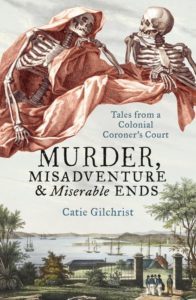
Social history, especially as it pertains to murder and
crime, will always be a lure to get me into a book. Catie Gilchrist’s account of Henry Shiell’s
33 year tenure as colonial Sydney’s City Coroner through a selection of the
cases over which he presided has been on my wish list for a while.
The cases that passed through Shiell’s court between 1866
and 1899 are presented in distinct categories: murder, manslaughter, suicide,
accidental deaths occurring through the hazards of work, transport and daily
life, and the deaths resulting from unwanted pregnancies, either through
abortion or infanticide. It’s a sad and sometimes sensational record of life
and death in a colonial city and the usual spread of human suffering, passion,
cruelty and pity.
Gilchrist doesn’t simply provide a litany of cases and their
outcomes – her research into various cases comes with commentary of how Sydney
society responded to notorious and sometimes heartbreaking cases. She also
records the instances of when inquests resulted in suggestions for changes in
laws and attitudes – whether such calls for change were ignored, embraced or
took several years for authorities to act.
Gilchrist adds her own observations on how poverty and
societal attitudes towards women and men affected various kinds of deaths,
remarking with asperity particularly on damaging and contradictory attitudes to
women and the poor (and poor women especially) that created situations in which
so much tragic death occurred.
The author’s occasional tendency to withhold the names of key perpetrators for effect was sometimes frustrating. The reader needs to stay alert too, as cases mentioned one or more chapters ago might come up again to demonstrate the timeline. (I took a four week break between starting and finishing this book, which meant I lost track a little!)
 Coffee and sticky notes: research essentials
Coffee and sticky notes: research essentialsThose quibbles notwithstanding, I read Murder, Misadventures and Miserable Ends: Tales from a Colonial Coroner’s Court with morbid fascination and finished it with a greater understanding of the conditions in Victorian-era Sydney. My copy is now festooned with sticky notes against cases and relevant laws that I may refer to for further research in my own writing.
September 2, 2019
Review: Circus Hearts 1 – All the Little Bones by Ellie Marney
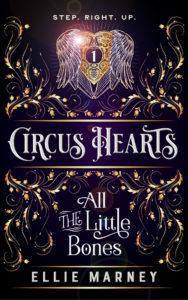
Ellie Marney’s Every… YA trilogy was fantastic, especially with it’s brushes of Sherlock Holmes characters and canon over its story of James Mycroft and Rachel Watts stumbling into crime (and into love) in an Australian setting. I’m delighted to find that the same deft gift for depth of character and neat plotting continues in the first of this new series.
I’ve read a few circus-themed books over the years, the most recent being Erin Morgenstern’s The Night Circus, which was all poetry, mysticism and elegant Victorian-era repressed romance fantasy.
Ellie Marney’s All the Little Bones (the first of the Circus Hearts trilogy) has a lot more crunch and texture. The sweat-and-greasepaint reality of it is more along the lines of Marion Zimmer Bradley’s The Catch Trap, but unlike that 1940s-50s-set and fairly brutal and unhappy exploration of queer love, All the Little Bones gives the reader both a gripping back story, and a romance with a kinder heart.
All the Little Bones follows Sorsha Neary, a teenaged trapeze artist, on the run from her family circus troupe after defending herself from an assault. The troupe’s apprentice strongman, Colm Mackay, is charged with taking her to safety, south to Klatsch’s Karnival.
Colm is supposed to be looking after Sorsha, not falling for her, especially as he was a witness to what happened. Sorsha is having nightmares, and when they finally reach the relative safety of Klatsch’s, not everyone is welcoming. The young pair have to negotiate their precarious situation with the law against trying to fit in to the new circus, along with the emotional fallout of the crime and how they are feeling about each other.
There’s a lot to juggle (pardon the circus pun) but Marney keeps everything at the perfect pitch and the perfect pace right to the end, when disaster of more than one kind brings everything to a head. The story handles the instigating crime and its consequences intelligently and compassionately, and while motivations can be doubted, the story is subtle enough not to have an outright, irredeemable villain. (Well, maybe one.)
It’s great to see the next book in the series, All Fall Down, builds on the events of All the Little Bones – I look forward to reading it soon!
Buy Circus Hearts 1: All the Little Bones
Circus Hearts: All The Little Bones [image error] (Amazon US)Amazon AUKoboNookiBooks
August 24, 2019
Review: Shadowmancy by Jason Franks
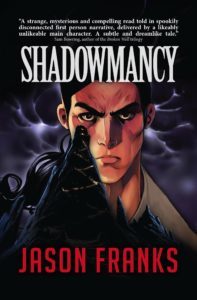
Jason Franks, who wrote the marvellous Bloody Waters and the dark, darkly funny and unexpected Faerie Apocalypse has given us a new story, expanded from a 6-page comic published in 2008. This fine history for Shadowmancy means that the novel is illustrated with some striking black and white art from Nicholas Hunter throughout.
We have so many stories about schools of sorcery, from the mystical mysteries of Dr Strange’s Himalayan retreat with the Ancient One, Hogwarts with its breathtakingly cavalier approach to duty of care and student safety, Pratchett’s The Unseen University and countless mountain-top Shaolin monk and ninja training camps from the movies.
Franks distills all of these tropes down into the sinister Academy, residing on a hidden mountain, where students attempt to absorb the Arts without being directly taught. The venerable Chancellor who gives the young Quay a chance to study there, after Quay’s father broke the most fundamental rule (don’t have a family) retains echoes of Dumbledore/Gandalf/Ancient One but he’s also his own scheming self.
That’s one of the joys of this book: all the echoes of fictions past, which draw on our collective memory of magic schools and give a frisson of recognition before taking sharp turns in its own direction, delivering a dark and gritty study of a boy who thinks he will out-learn them all. Quay is a misanthrope and sociopath, and still Franks makes him work as the central antihero.
Chosen One and teen hero tropes are inverted, sometimes messily, and the prose gives eloquent insights into philosophies of art, mind and power.
Shadowmancy is a crunchy little book, thoroughly enjoying, in its dark and brooding way, the dismantling of mystic-mountain-school pop culture. (Franks does like to invert tropes, which is a thing I love about his writing).
If you want to read about a magic school and what it’s probably really like, or if you just want dark fantasy fiction written by an author with a grip on his craft, I recommend this book with a Wahoo!
Buy Shadowmancy:
Shadowmancy [image error] (Amazon US) Shadowmancy links at Argonautica Press
August 18, 2019
Dublin WorldCon Ghost stories – “Jane” by Narrelle M Harris
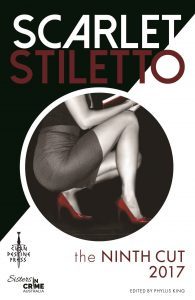
I had a blast reading an extract from my ghost story “Jane” at the Irish Ghost Stories panel at Worldcon tonight. Huge thanks to the fantastic Dr Jack Fennell who invited me to participate, and my fellow panellists.
“Jane” won the ‘Body in the Library’ award at the 2017 Scarlet Stiletto awards, and was published in Scarlet Stiletto: The Ninth Cut 2017.
A big shout out to all the people who came to me after the panel to ask how the story ends: you can get it in The Ninth Cut anthology, but the award sponsor, Melbourne’s Athenaeum Library, also has it online.
August 15, 2019
My Melbourne: Melbourne General Cemetery
 Melbourne General Cemetery
Melbourne General CemeteryI enjoy a
visit to a graveyard: these markers of the end of everyone’s story (or, for
believers, the end of the fist book and the beginning of the sequel).
One of my
favourite cemeteries is Melbourne General Cemetery, which dates from 1853.
Kitty Carrasco lives opposite this graveyard in Kitty and Cadaver, and there’s a very uncomfortable encounter with the dead rising from their graves and the ensuing musical battle where the minstrels try to sing the dead to rest again.
The
Melbourne General Cemetery contains the remains of hundreds of Melburnians from
all walks of life. Residents include great politicians, social reformers,
explorers, singers, public servants and sportsmen from the early days of the
colony.
Naturally,
there are writers and other contributors to Melbourne’s literary history among
the cemetery’s residents. These include Marcus Clarke, author of For the
Term of His Natural Life; city co-founder John Fawkner, who produced
Melbourne’s first newspaper; and John Stanley James, an early journalist who
wrote for “The Argus” newspaper under the pseudonym ‘The Vagabond’.
Explorers
Burke and Wills were buried here after their remains were recovered; opera
singer Frederick Federici, whose ghost is said to haunt the Princess Theatre,
is interred here.
One of the
charms of the Old Melbourne Cemetery (and, indeed, of all cemeteries) is the
occasional eccentric tombstone; whether it’s a pithy epitaph or an unusual
design carved in stone.

One of the most distinctive and evocative headstones in the cemetery is that of Emily Mather, murdered in 1891 by her husband Frederick Deeming (a serial killer who some believed to be Jack the Ripper).
The headstone remarks upon on her murder and gives some frankly victim-blaming advice on being careful who you marry.
 Walter Lindrum’s headstone
Walter Lindrum’s headstoneThe 1960 grave of world champion billiard’s player, Walter Lindrum, is much less gruesome – a few stone billiard balls and a cue lie across the polished marble, as though Walter has just stepped away for a moment and will be back to finish his shot shortly.
Another
unexpected memorial in Melbourne General Cemetery is the one to Elvis Presley –
curious, given Elvis never made it to Australia.
 The Elvis memorial
The Elvis memorialThe memorial is said to be the only officially approved shrine outside of Graceland. It was commissioned by the Elvis Presley Fan Club in 1977 and still attracts visitors each year on the anniversary of the hip-swiveller’s death.
Graves can be sad; they can even be morbid. I find them melancholy but restful, a reminder that every life, however, brief, has it’s own story, filled with love, drama, tragedy and joy.
Every story ends. I want to make sure the pages of mine are full.
August 8, 2019
My Library: Folklore and occult history

I have a growing collection of books about myths, legends, folklore and occult history that I’m working through and flagging with sticky notes. Whenever I find something music-related, in goes a tag while I consider how I might use it in a Kitty and Cadaver story.
The next Kitty & Cadaver book is being planned and will be set in the UK – its working title is currently Rivers and Ravens so naturally I’m also looking for material about waterways and corvids. 



